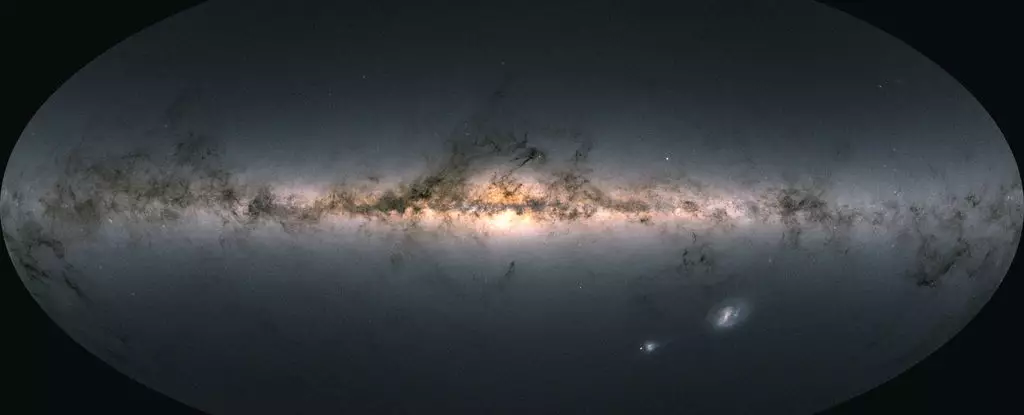Recent astrophysical studies have unveiled tantalizing hints of an extraordinary phenomenon lurking within the Large Magellanic Cloud (LMC), a satellite dwarf galaxy of the Milky Way. Astronomers have stumbled upon evidence of a supermassive black hole with a staggering mass—approximately 600,000 times that of our Sun. The LMC follows a spiraling path toward our galaxy, and the impending collision raises intriguing questions about the future dynamics of two massive galaxies. The prospect of such a supermassive black hole merging with the Milky Way’s own black hole, Sagittarius A*, presents an opportunity to examine black hole evolution in an unprecedented manner.
The Nature and Characteristics of Black Holes
Black holes, by their very nature, are difficult celestial phenomena to detect. They are defined by their immense gravitational pull, which prevents anything, including light, from escaping their grasp. Most black holes only reveal themselves through their interactions with surrounding matter—specifically, when they actively consume gas or stars, producing brilliant radiation during that process. This means that astronomers must employ indirect methods to discern their presence. One common strategy involves analyzing the orbits of nearby stars: if the motion of a star deviates significantly from what is expected, it may indicate the gravitational influence of an unseen black hole.
However, the research undertaken by Jiwon Jesse Han and colleagues from the Harvard & Smithsonian Center for Astrophysics diverges from traditional methods. Instead of scrutinizing typical stellar orbits, they focused on hypervelocity stars—rare objects that travel at extraordinary speeds, often challenging the confines of a galaxy’s gravitational pull. By examining these outliers, researchers hoped to pinpoint the influence of an elusive black hole on their trajectories, leading to groundbreaking insights into the formation and growth patterns of these enigmatic cosmic structures.
The investigation took advantage of data from the recently retired Gaia space telescope, which conducted an extensive survey of the Milky Way’s stellar population. By mapping the positions and velocities of stars, Gaia provided invaluable insights into the dynamic motions of various celestial bodies. Utilizing this dataset, the researchers analyzed a particular group of 21 hypervelocity stars, applying the “Hills mechanism” as a potential explanation for their extreme velocities.
The Hills mechanism describes a unique interaction among three bodies: a black hole and two stars. As the black hole passively influences the stars, one may be ejected at phenomenal speeds—effectively “yeeted” into intergalactic space. The team was able to methodically trace the origins of these stars, confirming that several of the hypervelocity stars traversing the Milky Way’s outer halo originated from the LMC.
As the LMC orbits the Milky Way, its inevitable collision is estimated to occur in roughly 2 billion years. This protracted event is less about a catastrophic smash-up and more akin to a slow-motion ballet of galaxies entwining. Over time, the two galaxies will merge, and the hidden black hole in the LMC will approach the Milky Way’s core, where it is likely to combine with Sagittarius A*, contributing to the growth of an even larger supermassive black hole.
The implications of this merger contribute significantly to our understanding of black hole development. It represents a crucial step in the narrative of how black holes evolve from smaller entities to gigantic supermassive structures that can host billions of solar masses. Observing such an evolution—even indirectly—offers astronomers a unique glimpse into a process that has shaped the cosmos over enduring epochs.
Despite the excitement surrounding this discovery, the true nature of the inferred black hole still requires verification through ongoing research. Future studies will aim to gather more data, enhancing our understanding of the LMC’s gravitational influences and the dynamics of hypervelocity stars. Each new piece of information will incrementally enrich our cosmic narrative—an ever-evolving tale of stars, gravitational pull, and the mysteries of the universe.
Uncovering the hinted existence of a black hole residing within the Large Magellanic Cloud not only enriches our understanding of black hole evolution but also highlights the intricate dance of galaxies in the universe. While we won’t witness this dramatic celestial merger in our lifetimes, the exploration and understanding of such events continue to be an exhilarating endeavor within modern astrophysics.


Leave a Reply